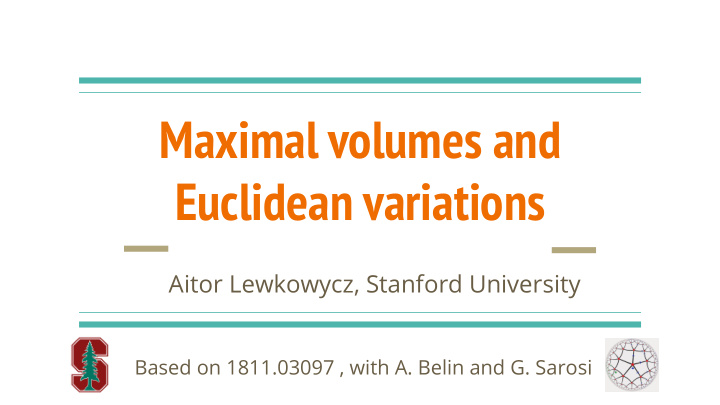



Maximal volumes and Euclidean variations Aitor Lewkowycz, Stanford University Based on 1811.03097 , with A. Belin and G. Sarosi
Introduction In the recent years, we have advanced a lot in our understanding of codim-2 surfaces and their quantum information interpretation: entanglement entropy and subregion - subregion duality. However, not much has been proven about codimension 1 surfaces : what is their use in QI QG? Focus on codim 1 surfaces dual to the boundary slice.
Overlaps! As discussed by Gabor, a natural way to obtain quantities localized in codimension 1 bulk surfaces is through wave functions overlaps . In particular the bulk symplectic form is dual to an antisymmetrized boundary overlap: where could be the metric and the stress-tensor and the states are naturally defined using the euclidean path integral.
Volume and EE analogies For entanglement entropy, we were able to make progress through the replica trick: a boundary deformation creates a conical singularity. Can we find a similar deformation for the maximal volume slice that ends at t=0?
Volume and EE analogies Following the analogy with entanglement entropy, it seems natural that the deformation is smooth in the bulk but becomes singular in the boundary. Close to the boundary of the entangling region creates a conical singularity. We expect that close to the surface, the metric deformation is discontinuous. As we will see, in the case of the vacuum, the simplest deformation with this property generates the volume: While in principle a similar local description should apply to more complicated cases, that seems hard to make precise.
Use symplectic form to understand volume!
Approach Obtain from the symplectic form: Volume generating , only around extremal surfaces: constraint equations. deforms extremal surface infinitesimally, same canonical fields: Not a diffeo: fields don't change (equiv change the fields keep surface fixed). It half a York time translation, so we called it the New York deformation. Similar to : bulk cutoff surface moves while keeping Dirichlet boundary conditions. In this case the bulk vector field acts trivially on the boundary.
Vacuum Obtain boundary deformation explicitly for simple geometries. Consider the vacuum in WdW coordinates (Euclidean bdy is at ):
Vacuum It is easy to show that . When mapped to Poincare coordinates, we have that The deformation is a diffeo only in the case when there is a time reflection symmetry and thus . Equivalent of Casini-Huerta-Myers for volumes. All these cases have for normalizable deformations.
Vacuum + matter fields In the presence of matter fields, Can recover this from the boundary point of view. One needs to look for the deformation of the scalar fields that satisfies This is a combination of the previous diffeomorphism plus a transformation of the sources, can be solved explicitly at large mass.
Thermofield double Need a extremal surface, simplest case Very symmetric case, extremal surface at . is spacelike in this WdW patch.
Thermofield double Can solve for the deformation in this background. We can plug the deformation into the boundary overlaps to obtain from a purely boundary calculation. The linear in behaviour arises from the fact that in the path integral preparation of the state, one has to integrate over long times .
Conclusion I have presented some motivation to approach the maximal volume in a similar way to entanglement. Then have pursued this using the dual of the symplectic form. Main limitation: general picture of the boundary deformation? Should be related with boundary states / singular deformations at . Local picture should be good to understand the divergences, but they are subtle. Alternatively, use in hyperbolic coordinates to generate these New York transformations [WIP] . Bulk arguments allow us to write the volume in terms of the trace of the stress tensor at large deformations.
T H A I N T S K F K S R N O A ! H M G T N Q I N U E B T S I T I L ! R O F THANKS HEP-TH!
Recommend
More recommend